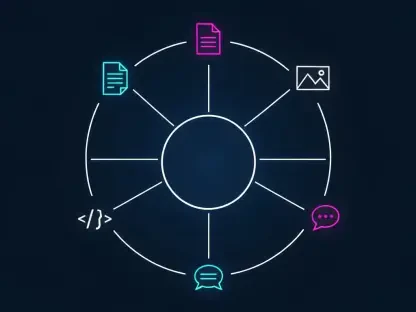The intersection of real-time data streaming and agentic artificial intelligence (AI) is poised to transform enterprise operations. This convergence represents a significant shift from chaotic data management to structured and actionable insights, offering businesses an unprecedented opportunity to achieve operational efficiency. The result is a landscape where companies can respond promptly to market changes, optimize processes, and harness the power of their data in real time.
The Role of Real-Time Data Streaming
Real-time data streaming has emerged as a crucial element in dispelling enterprise chaos, delivering a clearer and more structured approach to managing vast amounts of data. In dynamic environments where agentic AI is becoming increasingly integrated, the importance and scale of data streaming are set to grow exponentially. Companies are recognizing the need for robust underlying platforms capable of dissolving data siloes and seamlessly interpreting unstructured data. This paradigm shift means that enterprises can no longer afford fragmented data ecosystems that hinder their ability to derive meaningful insights in real time.
As businesses strive for agility and efficient decision-making, real-time data streaming provides the necessary foundation for high-speed data flow and processing. By continuously ingesting, processing, and analyzing data as it is generated, companies can maintain an up-to-date perspective on their operations. This capability transforms data from a static asset to a dynamic resource, fueling proactive decision-making and strategic planning. The convergence of live data streams and AI-driven analysis means that organizations can anticipate trends, mitigate risks, and seize new opportunities with unparalleled accuracy and speed.
Integration of AI with Real-Time Data
The traditional reliance on batch processing is rapidly becoming obsolete as continuous handling of real-time data is prioritized. AI plays a pivotal role in this transition, ensuring the consistent flow of structured, high-quality data. This integration is serving as a driving force behind the expansion of data streaming platforms, propelled by advancements in AI technologies. The ability of AI to process, cleanse, and contextualize data in real time is enabling enterprises to maintain a steady stream of valuable insights without the delays associated with batch processing methods.
AI’s capacity to handle real-time data streams also introduces a level of automation and intelligence previously unattainable. By embedding AI algorithms into data pipelines, businesses can automate the detection of anomalies, predict future trends, and even automate responses to emerging situations. This shift represents a profound enhancement in operational efficiency, as manual interventions are minimized and data-driven actions become more autonomous and precise. Consequently, AI-integrated data streaming is reshaping the way organizations interact with their data, driving innovation, and streamlining processes across industries.
Practical Applications and Examples
In practical terms, the integration of large language models (LLMs) with data streaming offers transformative benefits for various sectors. Delivery companies and grocery stores, for instance, face the ongoing challenge of maintaining accurate product catalogs. The traditional approach involves a labor-intensive process of data pulling, tagging, and interconnecting, which tends to delay the flow and validation of information. However, LLMs can revolutionize this process by significantly simplifying data interpretation. These models can determine item equivalence, refine product descriptions, categorize items, and identify potential advertising targets, thereby accelerating processes and enhancing accuracy.
For example, by integrating LLMs, a grocery store can automate the updating of its product database. Real-time data streaming allows LLMs to process incoming product uploads, understand their context, and make precise revisions to the catalog. This capability extends to dynamic pricing adjustments, inventory management, and targeted marketing campaigns. The enhanced accuracy and speed provided by AI-driven data streaming position businesses to operate more efficiently and respond to consumer demands promptly. This approach not only streamlines operations but also improves the consumer experience through timely and accurate information delivery.
Transformative Microservices
The integration of LLMs into workflows transforms them into streamlined microservices capable of understanding the real-time context derived from incoming events. Event-driven microservices, such as those fundamental to systems like Kafka, are inherently modular and enable scalable and flexible deployment across various domains. This modularity ensures that different components of an organization can be updated or replaced independently, promoting agility and reducing the complexity associated with monolithic systems.
Microservices architecture lends itself to the evolving nature of modern enterprises. By decoupling functionalities into smaller, independent services, organizations can innovate and adapt quickly. Each microservice can be optimized for specific tasks, ensuring that AI-driven enhancements in one area do not disrupt the entire system. This architectural approach, combined with real-time data streaming, allows businesses to deploy AI capabilities incrementally, building on existing data infrastructures without the need for costly and disruptive overhauls.
Tackling Legacy Systems
Operational challenges stemming from entrenched legacy applications within business operations present significant hurdles. Rebuilding these systems from the ground up is often prohibitively expensive and impractical. Instead, a more feasible approach involves capturing real-time streams from existing data sources and integrating them with new systems. This methodology enables modernization to occur organically, delivering return on investment (ROI) and maintaining operational continuity without significant disruptions.
By leveraging data streaming platforms, businesses can create a bridge between legacy systems and new AI-integrated environments. This strategy allows for the gradual phasing out of outdated processes while harnessing real-time data for immediate benefits. The real-time streams serve as a conduit for continuous data migration, ensuring that valuable historical data is integrated with current operational insights. This approach not only preserves the integrity of legacy data but also enhances it with real-time processing and AI-driven analysis, leading to a seamless evolution of enterprise data management systems.
Compliance and Governance Strategies
Highly regulated industries face the complex challenge of ensuring robust compliance and governance strategies. Confluent’s approach addresses these requirements through a three-pronged strategy. Firstly, the software is designed to adapt to multiple environments, including customer data centers and various cloud platforms. This flexibility ensures that enterprises can comply with diverse regulatory frameworks and operational requirements. Secondly, incorporating robust security and resilience features aligns with industry standards, providing an added layer of protection for sensitive data.
Structured data flows are critical in ensuring controllability and enforceability of governance policies. By systematically organizing data movement, organizations can track, audit, and manage sensitive information effectively. This is particularly important for tracking Personally Identifiable Information (PII) and other valuable assets. The structured nature of data streaming platforms allows for the establishment of comprehensive control and detailed audit trails, in stark contrast to ad hoc data management approaches. This meticulous structuring ensures clarity and traceability, essential for regulatory compliance and operational integrity.
Empowering Future AI Engineers
The collaboration between real-time data streaming and agentic artificial intelligence (AI) stands to revolutionize enterprise operations. This combination marks a significant evolution from disorganized data management to structured, actionable insights, providing businesses an extraordinary chance to enhance operational efficiency. With this progression, companies will be able to respond swiftly to market changes, streamline processes, and leverage their data powerfully and instantly.
In the past, businesses struggled with disconnected data sources, leading to inefficiencies. Real-time data streaming changes this by enabling continuous data flow. When paired with autonomous AI systems capable of learning and decision-making, the possibilities for optimization are vast. For instance, predictive analytics can foresee market trends, allowing companies to adapt proactively. Operational tasks can also be automated and improved through informed decisions, reducing human error and increasing productivity.
As enterprises integrate these technologies, they are better equipped to stay competitive, innovative, and responsive in an ever-evolving market landscape.









